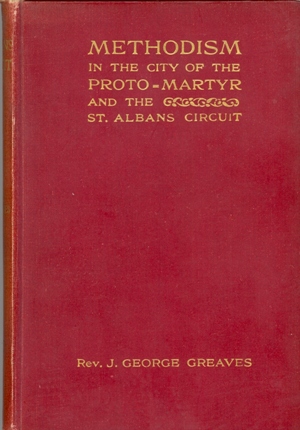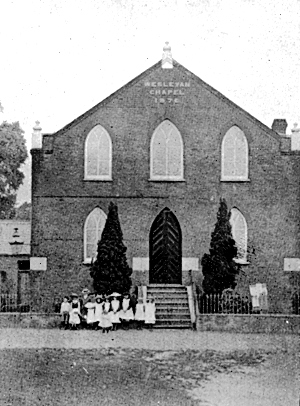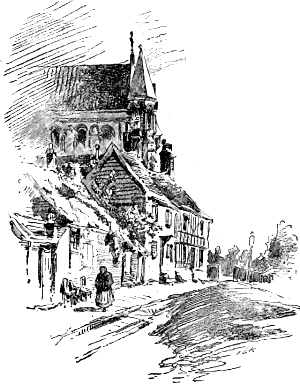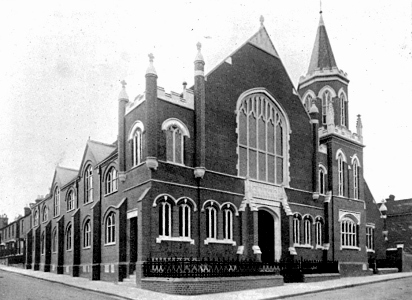|
|
Methodism by Rev J. George Greaves Published by Gibbs & Bamforth, 1907
Hardback, 152 pages & 16 plates |
 |
|||
|
In addition to information directly related to St Albans there are also sections on other Methodist churches in the circuit. The following extract describes the early days in Redbourn. REDBOURN is a village about four miles from St. Albans, on its northern side, with an extensive Common and a quaint old Church, which, in some portions of its structure, dates back to an early English period. The bones of Amphibalus are said to have been discovered on Redbourn Green in 1178. Shortly after Mr. John Wood, who was a native of Redbourn, attached himself to Methodism in St. Albans, services were commenced here, and a dwelling-house of Sarah Law was certified for Methodist worship by him, Samuel Copleston, and John Humphries. No separate Society was formed. If any members existed, they were included in the St. Albans list of the Bedford Circuit. Methodism does not appear to have made much headway at this early date, for in 1825, the services were still held in a dwelling-house, the house of Mr. Whitehouse being certified on the 13th April of that year, the persons certifying being the Rev. J. Wilson Pipe, Messrs. Wm. Whitehouse, John Wood, Thomas Wood, Wm. Irons, and Edward Herbert; and on the 10th November, 1825, the house of Wm. Eames, miller, Redbourn, was certified for worship by the Rev. R. Cooper. The arrival of Mr. Eames in the village did much to promote the cause. It was not, however, until 1827 that a separate Society was formed, and the Society Class was met by the preacher appointed on the Sunday. The following is the list of members at that time, viz., Elizabeth Manning, Mary Eames, Phoebe Hutchings, Ann Austin, Mary A. Robinson, John Philpot, Sarah Smith, William Eames, Elizabeth Mailing, Ann Philpot, and Thos. Sharp (O. T.) Shortly afterwards the names of Thomas Quick, Mary Coleman, Ann Reading, Mary Davies, and Elizabeth Hawkins appear. Mr. W. Eames acted as the first Society Steward. The earliest recorded Leader, as distinct from the preachers, is William Seabrook, in 1834, and there were thirteen members. In the following year, the membership had doubled and the need was felt for a chapel. A document is preserved, dated December 8th, 1835, by which the consent of the General Chapel Committee was sought for the erection of a chapel, 31 by 21 feet, outside measure. The average number of hearers was then stated to be 120, and the population of the village 2,000. The cost of the building was £180, and the land £20. The application was signed by the Rev. Richard Gower. In June, 1836, Mr. Jacob Harrison and others were admitted to the copyhold, and, on April 8th, 1837, the building was registered for public worship. The chapel became a centre of increased activity. The book also looks at the fate of some of the earlier groups - and the following extracts relate to Sarratt and Flaunden The little cause at Sarratt, which appeared next to Watford, on the Circuit plan, in 1824, had then ten members, and the leader was Mr. George Harding. The following year the Society, as such, became extinct, both the Society Steward and Leader, with their families, disappearing from the list, while some of the members appear under the head of Rickmansworth. In 1839, Sarratt reappears, the class being in charge at Mr. Austin. For some years, it is returned with fifteen members, but in 1847 it finally vanished from the Records. The Superintendent in December, 1847, remarks :--" This quarter we lost Sarratt; the members preferring the Baptist worship in a good, new chapel, to worshipping in a blacksmith's shoeing shed, within the sound of a beerhouse. The place should be visited again, however. " The previous quarter it was returned a having ten members. The Flaunden Society, with its ten members in 1825, was met by the preacher on the Sunday. In 1829 the Society Stewards were Mr. Harris and Mr. Breed. ]n June, 1834, Mr. Eames was the Class Leader, with a membership of twenty-one, and he acted as Society Steward. Shortly afterwards, his name disappears, Mr. Thomas Harris becoming leader, but, in 1839, the Society had become extinct. |
CONTENTS
APPENDIX
|
||||

For membership lists in 1825 see Bovingdon, Flaunden & Sarratt For Information on the Rev. Thomas Collins see The Life of the Rev. Thomas Collins There is a web page for Religion in Hertfordshire
Page updated December 2007
|
|||||
 |
These pictures show the outhouse used for worship in Romeland, St Albans, and the Marlborough Road Church opened in 1898, |


